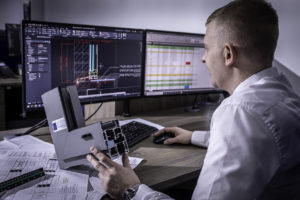Construction had to adapt to new and digital ways of working but will Zoom continue to have a place after things get back to ‘normal’?
Craig Key, Pre-Construction Manager, Acorn Aluminium Discusses.
I’m responsible for getting a project from concept stage on to site so that’s design scheduling and a small amount of programming. That means a lot of meetings.
Pre-COVID-19 we’d attend design team meetings once every two to three weeks. COVID-19 changed that, we were using digital tools to a point but when it hit, it accelerated adoption of digital platforms in our business – Zoom, Teams, like they did for almost everyone of working age, became a key part of how we worked.
We couldn’t get out there and meet people as we had done previously and it was in a sense ‘sink or swim’, we had find a way so that projects could continue to be delivered and as a business we remained solvent. Cash had to flow as it needed to do for everyone.
The other factor was that demand wasn’t simply turned off with lockdown. We had projects about to start, part delivered and to tender for. We had to keep working.
Having lived and worked with COVID-19 now for the best part of two-years, those digital tools have transformed how we work. I get it that people are a little bit Zoom-weary but as part of planning and delivery, Zoom and Teams deliver a number of benefits.
The additional flexibility they give us in who we can meet and when translates into far more effective project delivery. We’ve gone from DTMs once every two to three weeks, to once or twice a week and still use the same amount of resource and time but massively improve communication building a far better relationship with the contractor. You’re seeing more of each other, and you have a better understanding of what the other is trying to do.
For example, if you’ve got a design issue it’s much easier to chat it through face-to-face, you can share your screen and highlight the problems you’re seeing through design and you can develop the design or the build to work around that. You don’t have to travel to their offices to sketch it out.

Going back to design team meetings, if you’re only there every two to three weeks a lot can change in the design and you don’t always have the opportunity to comment on those changes. You only have to miss one meeting and you could find that there’s a key element in your scope of works that you’re not aware of. That could mean you have to put in a lot more resource to get to the point that you should be at.
Now because we’re there at each meeting, either in person or online, we can pick up on things that might trip us up or trip up the contractor further down the line, however, small or large they might be.
Online tools are making the delivery of new buildings more efficient, cost effective and better. Being there, either in person or on a Teams/Zoom call, it doesn’t matter, we’re there to take part every step of the way.
The challenges that we’ve seen and continue to see in the supply chain make that even more important. It’s not only our customers that we meet with regularly across Zoom and Teams, it’s our suppliers.
Online channels have allowed us to work more closely with our suppliers, to meet face to face, rather than simply sending emails backwards and forwards. And because of that we’ve been able to keep contractors better informed and to reschedule things where we need to, to make the supply chain work as best we can.
I love an onsite meeting but there is an element that it takes up so much resource just travelling. And that is important. We’ve got a lot of work on, and we have a responsibility to use the time that we have as best as we can and three or four hours on the road is not an efficient use of resource.
That doesn’t mean going to site isn’t important. Being there once a month to see the building go up and how it’s progressing will always be part of our approach. It allows you to pick up on things that you might otherwise miss – but for me, it’s part of a hybrid solution, which combines those meetings with digital ones, maximising value for all parties on every project.

